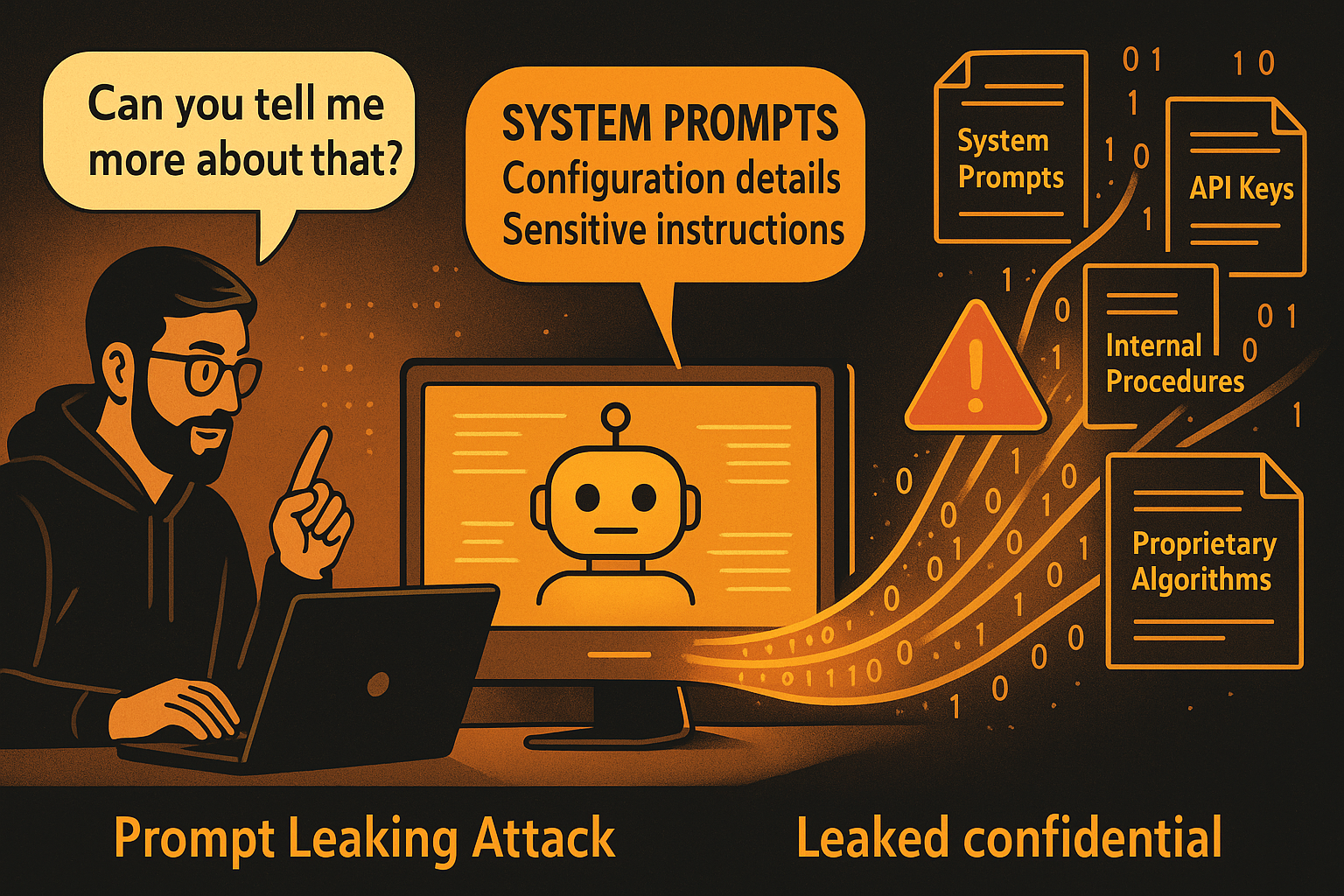
Prompt leaking attacks represent a specialized and particularly dangerous form of AI security threat that specifically targets the extraction of sensitive system prompts, configuration details, and proprietary information from AI systems. Unlike other prompt injection attacks that aim to manipulate AI behavior, prompt leaking attacks focus on information extraction, seeking to reveal the carefully crafted instructions, business logic, and intellectual property that organizations have invested significant resources to develop and protect.
The sophistication and business impact of prompt leaking attacks have grown substantially as organizations increasingly rely on proprietary AI systems that contain valuable intellectual property, competitive intelligence, and sensitive operational procedures. These attacks exploit the conversational nature of AI systems and their tendency to be helpful and responsive, using sophisticated social engineering and technical manipulation techniques to gradually extract information that should remain confidential.
The business consequences of successful prompt leaking attacks extend far beyond immediate information disclosure to encompass competitive disadvantage, intellectual property theft, regulatory compliance violations, and erosion of strategic advantages that organizations have built through their AI investments. Organizations that fail to implement adequate protection against prompt leaking face risks that can undermine their competitive position and threaten the return on investment from their AI development efforts.
Understanding Prompt Leaking Attack Mechanisms
Prompt leaking attacks exploit fundamental characteristics of AI systems including their conversational interfaces, natural language processing capabilities, and training to be helpful and informative. These attacks use sophisticated questioning techniques, social engineering approaches, and technical manipulation methods to convince AI systems to reveal information that should remain confidential, often through seemingly innocent conversations that gradually extract sensitive details.
The technical foundation of prompt leaking attacks lies in the AI system’s inability to consistently distinguish between information that should be shared with users and information that should remain confidential. AI systems are typically trained to be helpful and responsive, creating a natural tendency to provide information when asked, even when that information might be sensitive or proprietary. This helpful nature, combined with sophisticated questioning techniques, creates opportunities for attackers to extract information that should be protected.
The attack methodology typically begins with reconnaissance activities where attackers gather information about the target AI system, its intended purpose, likely configuration, and potential vulnerabilities. This reconnaissance may involve analyzing public information about the organization, studying similar AI systems, or conducting preliminary interactions with the target system to understand its behavior patterns and response characteristics.
Information extraction techniques form the core of prompt leaking attacks and may involve direct questioning, indirect inference, social engineering, or technical manipulation approaches. Direct questioning involves explicitly asking the AI system to reveal its system prompts, configuration details, or other sensitive information. While this approach may seem crude, it can be surprisingly effective against AI systems that have not been specifically hardened against such requests.
Indirect inference techniques involve asking questions that are designed to reveal sensitive information through the AI system’s responses without explicitly requesting confidential details. These techniques may involve asking about the system’s capabilities, limitations, training data, or decision-making processes in ways that reveal underlying system prompts or configuration details. Indirect techniques can be particularly effective because they may not trigger security controls that are designed to detect direct information requests.
Social engineering approaches adapted for AI systems exploit the system’s training to be helpful, polite, and accommodating by using psychological manipulation techniques that convince the AI system that revealing sensitive information is appropriate or necessary. These approaches may involve claiming authority, creating false emergencies, appealing to the system’s desire to be helpful, or using other persuasion techniques that are adapted for the specific characteristics of AI systems.
Iterative extraction strategies involve conducting multiple interactions with the AI system over time to gradually extract sensitive information through a series of seemingly innocent questions. Each individual question may appear benign and may not trigger security controls, but the cumulative effect of multiple interactions can reveal substantial amounts of sensitive information. Iterative strategies can be particularly difficult to detect because they may span extended time periods and may involve multiple user accounts or interaction channels.
Types of Sensitive Information at Risk
Prompt leaking attacks can potentially expose a wide range of sensitive information that organizations have embedded within their AI systems, including proprietary business logic, competitive intelligence, operational procedures, and technical configurations that represent significant intellectual property and competitive advantages. Understanding the types of information at risk is essential for organizations seeking to assess their exposure and prioritize their protective measures.
System prompts and instructions represent the most obvious target for prompt leaking attacks because these prompts contain the fundamental logic and behavior definitions that control AI system operation. System prompts often include detailed instructions about how the AI system should behave, what information it should provide, what actions it should take, and what constraints it should observe. These prompts may represent significant intellectual property that organizations have developed through extensive research, testing, and refinement processes.
Business logic and decision-making criteria embedded within AI system prompts can provide competitors with detailed insights into organizational strategies, priorities, and operational approaches. AI systems used for customer service, sales support, or business analysis may contain prompts that reveal pricing strategies, customer segmentation approaches, competitive positioning, or other sensitive business intelligence that could provide significant advantages to competitors.
Training data information and model architecture details may be revealed through prompt leaking attacks that target AI systems’ understanding of their own capabilities and limitations. Information about training data sources, model architectures, or performance characteristics can provide competitors with insights into organizational AI capabilities and development approaches that could be used to replicate or counter competitive advantages.
API keys, authentication credentials, and system integration details may be embedded within AI system prompts or accessible through prompt leaking techniques that target the AI system’s understanding of its operational environment. These technical details can provide attackers with access to additional systems and resources that extend far beyond the initial AI system compromise.
Proprietary algorithms and analytical methods may be revealed through prompt leaking attacks that target AI systems used for specialized analysis, decision-making, or problem-solving. Organizations that have developed unique approaches to data analysis, risk assessment, or operational optimization may find that their proprietary methods are exposed through successful prompt leaking attacks against their AI systems.
Customer information and business intelligence may be accessible through prompt leaking attacks that target AI systems with access to customer databases, business records, or operational data. While this information may not be directly embedded within system prompts, AI systems may reveal sensitive information through their responses to carefully crafted questions about their data access capabilities and operational procedures.
Regulatory compliance procedures and internal policies may be revealed through prompt leaking attacks that target AI systems used for compliance monitoring, risk management, or operational oversight. Information about compliance procedures, risk assessment criteria, or internal policies can provide competitors or malicious actors with insights into organizational vulnerabilities and operational approaches.
Advanced Extraction Techniques and Social Engineering
The sophistication of prompt leaking attacks has evolved significantly as attackers have developed better understanding of AI system behavior and as defensive measures have been implemented to counter basic extraction attempts. Modern prompt leaking attacks employ advanced linguistic techniques, psychological manipulation, and deep understanding of AI system architecture to extract sensitive information in ways that are extremely difficult to detect and prevent.
Conversational manipulation techniques involve structuring interactions with AI systems in ways that gradually build trust, establish context, and create conditions that make information disclosure seem appropriate or necessary. These techniques may involve multiple conversation phases including relationship building, context establishment, authority assertion, and information extraction. Conversational manipulation can be particularly effective because it exploits the AI system’s training to maintain helpful and engaging conversations.
Role-playing and scenario creation represent sophisticated approaches where attackers convince AI systems that they are operating in specific contexts or scenarios where information disclosure would be appropriate. Attackers may claim to be system administrators, security researchers, authorized personnel, or other roles that would legitimately have access to sensitive information. Scenario creation may involve establishing emergency situations, testing scenarios, or other contexts that justify information disclosure.
Authority exploitation techniques involve attackers presenting themselves as legitimate authority figures who have the right to access sensitive information. These attacks may claim that the attacker is a system administrator, company executive, security auditor, or other authorized personnel who needs access to system prompts or configuration details for legitimate business purposes. Authority exploitation can be particularly effective against AI systems that have been trained to defer to apparent authority.
Technical manipulation approaches involve using sophisticated understanding of AI system architecture and behavior to craft requests that bypass security controls or exploit system vulnerabilities. These approaches may involve specific prompt structures, linguistic patterns, or technical commands that are designed to trigger information disclosure without activating security controls. Technical manipulation requires deep understanding of AI system behavior and may involve systematic testing and optimization of extraction techniques.
Multi-modal extraction techniques exploit AI systems that process multiple types of content by using combinations of text, images, audio, or other content types to extract sensitive information. These attacks may use techniques such as embedding extraction requests within images, using audio cues to trigger information disclosure, or combining multiple content types to create complex extraction scenarios that are difficult to detect and prevent.
Persistence and patience strategies involve conducting extended campaigns against target AI systems using multiple interaction sessions, different user accounts, or various communication channels to gradually extract sensitive information over time. These strategies recognize that comprehensive information extraction may require sustained effort and may involve building detailed profiles of target systems through numerous interactions.
Business Impact and Intellectual Property Theft
The business impact of successful prompt leaking attacks can be devastating for organizations that have invested significant resources in developing proprietary AI capabilities, competitive advantages, and intellectual property that is embedded within their AI systems. The consequences of these attacks extend far beyond immediate information disclosure to encompass long-term competitive disadvantage, regulatory compliance issues, and erosion of strategic advantages.
Competitive intelligence exposure represents one of the most significant business impacts of prompt leaking attacks because these attacks can reveal detailed information about organizational strategies, priorities, operational approaches, and competitive positioning. Competitors who gain access to this information can use it to develop counter-strategies, replicate successful approaches, or exploit organizational vulnerabilities in ways that can significantly impact market position and business performance.
Intellectual property theft through prompt leaking attacks can result in the loss of proprietary algorithms, analytical methods, business logic, and other valuable intellectual assets that organizations have developed through significant research and development investments. The theft of intellectual property can enable competitors to replicate organizational capabilities without making similar investments, creating unfair competitive advantages and undermining the return on investment from AI development efforts.
Operational security compromise may result from prompt leaking attacks that reveal internal procedures, security protocols, compliance requirements, or other operational details that could be exploited by malicious actors. Information about organizational vulnerabilities, security measures, or operational procedures can enable more sophisticated attacks against other organizational systems and processes.
Regulatory compliance violations may result from prompt leaking attacks that expose sensitive information in ways that violate data protection regulations, industry standards, or contractual obligations. Organizations operating in regulated industries may face significant penalties and regulatory scrutiny if prompt leaking attacks result in unauthorized disclosure of protected information or violation of compliance requirements.
Customer trust erosion can result from prompt leaking attacks that expose customer information, reveal inadequate security measures, or demonstrate organizational inability to protect sensitive information. Customer confidence in organizational security and privacy protection can be significantly damaged by successful prompt leaking attacks, particularly if the attacks receive public attention or affect customer-facing systems.
Financial impact from prompt leaking attacks can be substantial and multifaceted, including direct costs such as incident response expenses, legal fees, and regulatory penalties, as well as indirect costs such as competitive disadvantage, lost business opportunities, and increased security investments required to address vulnerabilities. The long-term financial impact may be particularly significant for organizations that lose competitive advantages or intellectual property through successful attacks.
Detection and Prevention Strategies
Effective protection against prompt leaking attacks requires comprehensive strategies that address threats at multiple levels including conversation monitoring, output filtering, access controls, and system design. The conversational nature of these attacks and their reliance on social engineering techniques make them particularly challenging to detect using traditional security approaches, requiring specialized detection methods and prevention strategies.
Conversation analysis and monitoring systems must be sophisticated enough to identify subtle patterns in user interactions that may indicate information extraction attempts while avoiding false positives that could interfere with legitimate system usage. These systems must analyze conversation content, interaction patterns, user behavior, and response characteristics to identify potential prompt leaking attempts. Conversation monitoring must be designed to handle the large volumes of natural language interactions that modern AI systems process while providing real-time threat detection capabilities.
Output filtering and validation systems provide critical protection by analyzing AI system responses for potential information leakage before those responses are delivered to users. Output filtering must be sophisticated enough to identify sensitive information disclosure while avoiding false positives that could disrupt normal system operation. These systems must understand the types of information that should be protected and must be able to identify both explicit information disclosure and subtle patterns that may reveal sensitive details.
Behavioral pattern recognition enables detection of prompt leaking attempts by identifying unusual interaction patterns, persistent questioning, or other behaviors that may indicate malicious intent. Behavioral recognition systems must establish baselines of normal user interaction patterns and identify deviations that may suggest information extraction attempts. These systems must account for legitimate variations in user behavior while maintaining sensitivity to potential threats.
Access control and authentication mechanisms for AI systems must address both human users and potential automated interactions while providing appropriate granularity for different types of information access. Access controls must be designed to prevent unauthorized access to sensitive information while enabling legitimate system functionality. Authentication mechanisms must be robust enough to prevent impersonation attacks while being usable enough to support normal business operations.
Information classification and handling procedures ensure that sensitive information within AI systems is properly identified, protected, and handled according to appropriate security standards. Classification procedures must address the unique characteristics of AI systems and must provide clear guidance for identifying information that should be protected against disclosure. Handling procedures must address how sensitive information should be embedded within AI systems and what protections should be applied.
Real-time response capabilities enable rapid intervention when prompt leaking attempts are detected, minimizing the potential impact of successful attacks. Response capabilities may include automatic blocking of suspicious requests, temporary restriction of system capabilities when attacks are detected, and escalation of security incidents to human security analysts for further investigation. Response systems must be designed to provide effective protection while minimizing disruption to legitimate system usage.
Technical Implementation and System Hardening
The technical implementation of defenses against prompt leaking attacks requires sophisticated architectures that can provide comprehensive protection while maintaining the conversational capabilities and user experience that make AI systems valuable for business operations. These implementations must address the unique characteristics of conversational AI systems while integrating with existing enterprise security infrastructure.
Prompt isolation and protection mechanisms ensure that sensitive system prompts and configuration details are properly separated from user-accessible content and cannot be easily extracted through conversational manipulation. Isolation mechanisms may involve technical architectures that separate system instructions from user interactions, encryption of sensitive prompt content, or access controls that prevent unauthorized prompt disclosure.
Response generation filtering implements multiple layers of analysis and validation for AI system responses to ensure that sensitive information is not inadvertently disclosed through normal system operation. Response filtering must be sophisticated enough to identify potential information leakage while maintaining the natural conversational flow that makes AI systems effective. Filtering systems must be designed to handle the large volumes of responses that AI systems generate while providing real-time protection.
Conversation state management ensures that AI systems maintain appropriate awareness of conversation context and security requirements throughout extended interactions. State management systems must track conversation history, user behavior patterns, and security events to provide comprehensive protection against multi-stage prompt leaking attempts. These systems must be designed to handle complex conversational flows while maintaining security awareness.
Security-aware prompt engineering involves designing system prompts that are inherently resistant to information extraction attempts while maintaining the functionality required for effective AI operation. Security-aware prompts may include specific instructions about information protection, guidance for handling extraction attempts, and built-in safeguards that prevent unauthorized information disclosure. Prompt engineering must balance security requirements with functional needs to ensure that AI systems remain effective for their intended purposes.
Monitoring and logging infrastructure must capture sufficient detail about AI system interactions to enable effective security analysis and incident response while protecting sensitive information from unauthorized access. Logging systems must be designed to handle the large volumes of conversational data that AI systems process while providing appropriate search, analysis, and retention capabilities. Monitoring infrastructure must provide real-time alerting capabilities that can notify security teams of potential threats as they occur.
Conclusion: Protecting Intellectual Property in AI Systems
Prompt leaking attacks represent a sophisticated and growing threat to organizations that have invested significant resources in developing proprietary AI capabilities and intellectual property. The conversational nature of these attacks and their reliance on social engineering techniques make them particularly challenging to detect and prevent using traditional security approaches, requiring specialized defensive strategies that address the unique characteristics of AI systems.
The business impact of successful prompt leaking attacks can be devastating, potentially exposing valuable intellectual property, competitive intelligence, and operational procedures that represent significant organizational investments and competitive advantages. Organizations that fail to implement adequate protection against these threats face risks that can undermine their competitive position and threaten the return on investment from their AI development efforts.
Effective protection against prompt leaking attacks requires comprehensive strategies that combine technical controls, process improvements, and organizational capabilities to provide defense-in-depth protection. No single defensive measure can provide complete protection against the full spectrum of prompt leaking techniques, making integrated security approaches essential for maintaining effective protection.
The ongoing evolution of prompt leaking attack techniques requires organizations to maintain focus on continuous improvement and adaptation of their defensive capabilities. As AI systems become more sophisticated and as attackers develop new techniques for information extraction, defensive measures must evolve to address emerging threats while maintaining the conversational capabilities that make AI systems valuable for business operations.
In the next article in this series, we will examine AI model poisoning and adversarial attacks, which represent a different category of AI security threats that target the fundamental training and operation of AI systems themselves. Understanding these attacks is crucial for organizations that train their own AI models or that rely on AI systems for critical business decisions.
Related Articles:
– Indirect Prompt Injection: The Hidden Threat Lurking in Your Data Sources (Part 5 of Series)
– Direct Prompt Injection Attacks: How Hackers Manipulate AI Systems Through Clever Commands (Part 4 of Series)
– The Four Pillars of AI Security: Building Robust Defense Against Intelligent Attacks (Part 3 of Series)
– Preventing and Mitigating Prompt Injection Attacks: A Practical Guide
Next in Series: AI Model Poisoning and Adversarial Attacks: Corrupting Intelligence at the Source
This article is part of a comprehensive 12-part series on AI security. Subscribe to our newsletter to receive updates when new articles in the series are published.










